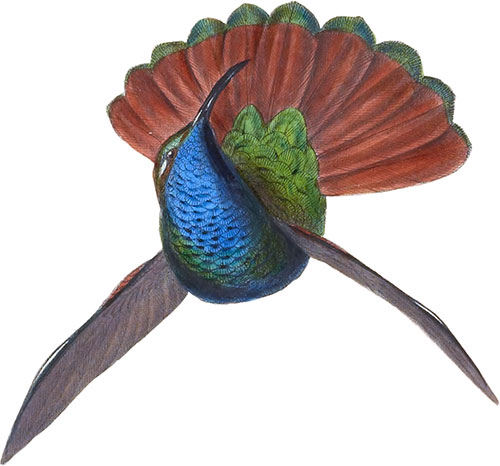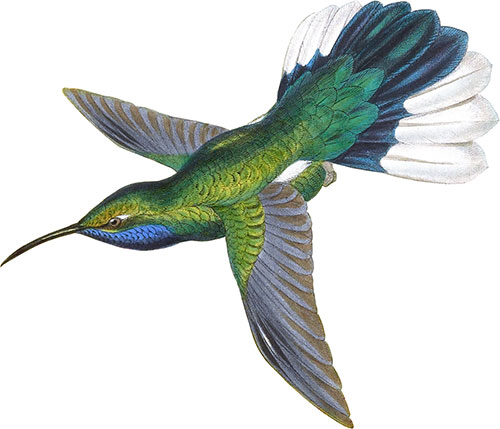De Lattre’s Sabre-wing
Mexico and Guatemala
Of all the members of the genus Campylopterus, the present is by far the largest and the most beautifully coloured. It is said to be the boldest species of its race, and to be so extremely pugnacious, that every bird venturing into the neighbourhood of its territory is furiously attacked and driven away; this peculiar feature in the habits of the bird explains the uses of the broad and powerful shafts of the primaries, which form so conspicuous a character in the males of all the Campylopteri.
The present bird is strictly a Mexican and Central American species. I have lately received from Mr. Skinner some very beautiful specimens which were procured in Guatemala by M. Riviera Paz, whom I have had occasion to mention in my account of other species. M. De Lattre, to whom we are indebted for its discovery, and after whom it has been named, states that it is found in the forests of Jalapa during two months of the year only; that it is known by the name of the ‘Suce fleurs-royal,’ and that it feeds during the entire day, and not during any particular hours. He adds that it selects a flowering shrub, which it never quits, and from which it chases with anger all the other species of the family that may seem desirous of approaching it: on taking flight it utters a cry.
Considerable difference exists, not only in the size, but in the colouring of the sexes of this species; the female being very much less and very plainly coloured when compared with the male, and destitute of the dilatations of the shafts of the primaries.
The male has the lores, forehead and crown dull bluish black; behind the eye a small spot of white; all the upper and under surface rich deep violet-blue; wing-coverts, rump and upper tail-coverts green, into which the blue of the upper surface blends; wings dark purplish brown; tail steel-black, the three outer feathers on each side largely tipped with white, slightly margined in some specimens with black; vent greyish white; under tail-coverts steel-black, glossed with green; bill black; feet dark brown.
The female has the head dark bronzy brown; all the upper surface, wing- and tail-coverts and flanks brilliant green, glossed with golden on the back of the neck and wing-coverts; two centre tail-feathers glossed with green for two-thirds of their length from the base; down the centre of the throat a mark of shining greenish blue; remainder of the under surface grey, glossed with green.
The figures represent an adult male, a young male and a female of the size of life. The beautiful flower, which is also indigenous to Guatemala, is the Lælia majalis.
 Campyloterus lazulus
Lazuline Sabre-wing
Campyloterus lazulus
Lazuline Sabre-wing
 Campylopterus ensipennis
Blue-throated Sabre-wing
Campylopterus ensipennis
Blue-throated Sabre-wing
 Campylopterus splendens
Villavicencio’s Sabre-wing
Campylopterus splendens
Villavicencio’s Sabre-wing
 Campylopterus Villavicencio
Villavicencio’s Sabre-wing
Campylopterus Villavicencio
Villavicencio’s Sabre-wing
 Campylopterus latipennis
Broad-shafted Sabre-wing
Campylopterus latipennis
Broad-shafted Sabre-wing
 Campylopterus obscurus
Sombre Sabre-wing
Campylopterus obscurus
Sombre Sabre-wing
 Campylopterus rufus
Fawn-breasted Sabre-wing
Campylopterus rufus
Fawn-breasted Sabre-wing
 Campylopterus hyperythrus
Rufous-breasted Sabre-wing
Campylopterus hyperythrus
Rufous-breasted Sabre-wing
 Campylopterus phainopeplus
Simons’s Sabre-wing
Campylopterus phainopeplus
Simons’s Sabre-wing
Featuring all 422 illustrated species from John Gould’s A Monograph of the Trochilidæ, or Family of Humming-Birds arranged by color.